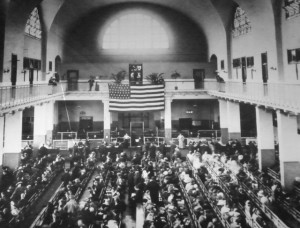
Click the flag to view the hall today
At the turn of the century, millions of immigrants passed through Ellis Island, the largest and most famous processing center of the US immigration service. Among those where Luigi Viani, Giulia Calzia, Ilonka Tatarek, Rista Mitrovitc, Salvatore Granucci, Timothy Geary, and Ellen Coughlan—all of whom are grandparents of Nick or Sooney Viani. While we sadly don’t have first-person accounts of their experience, our recent visit to New York included a visit to the formidable National Park. From first boarding the ferry, to the welcoming by the Statue of Liberty, and finally to passing through the massive portal to an even more impressive “baggage” room, our visit paralleled what must have been a terrifying, if not euphoric event for our relatives. With trepidation, I entered the vast, almost sacred hall, allowing myself to imagine the experience through the eyes of my 24-year-old grandmother, Ilonka Tatarek, who traveled from Hungary with her older sister, Gizella. Our visit was particularly interesting thanks to the intelligent and animated account presented by our personal guide, a national park ranger.
Because the goal of the immigration service was to dazzle new arrivals, the building was designed by a young architectural firm of visionaries who incorporated futuristic features into the building (shunning the dark, heavy Victorian elements common to the late 1880’s) that featured huge windows and skylights creating an open and welcoming atmosphere. Agents were trained to be polite and friendly and, when necessary, provided compassionate and efficient medical attention. The director of the facility, William Williams, was specifically appointed by Theodore Roosevelt 1901, not because of his political affiliation (he was actually opposed to mass immigration) but because of his kindness, efficiency, and sensitivity. Roosevelt ordered him to train his staff to treat the arrivals as if they were his personal guests and that became the code of the Ellis Island employees.

even more daunting experience of connecting
with countrymen for a meal, a bed, and a job.
From the colonial era to the end of the 19th century, each state had borne responsibility for regulating immigration. But with the swelling numbers of immigrants in the 1880s and 1890s, coupled with an increasingly complex industrial economy and mounting concern about the spread of infectious diseases, the federal government took control of the nation’s borders in 1891. While admission decisions were made by the Immigration Service, the law required medical inspection of immigrants by the United States Public Health Service (PHS). In the opinion of our guide, Ellis Island was the largest mass immigration in the history of human civilization and will never again be equaled. Between 2-3,000 people were processed daily and the system was streamlined for efficiency. Working 7 days a week, nearly 13 million immigrants were processed through Ellis Island between 1892-1924. Upon docking, steerage or third-class passengers were ferried to Ellis Island by barge. They were herded into the baggage room and instructed to leave their one bag behind (that’s all they were permitted to travel with) and proceed through a series of gated passageways resembling cattle pens. At the end of the “line,” they ascended a set of stairs to the “registry” room (or Great Hall). During that climb, they were surveyed by medical examiners for a variety of diseases and conditions that included having their eyelids turned back with fingers or a “buttonhook” to check for trachoma (an eye disease that could lead to blindness).
The diagnostic protocol emphasized the physician’s “gaze,” demonstrating the conviction that disease was written on the body. Dr. Albert Nute, while stationed in Boston, argued that “almost no grave organic disease can have a hold on an individual without stamping some evidence of its presence upon the appearance of the patient evident to the eye or hand of the trained observer.”
With that protocol in mind, officers placed a chalk mark on the clothing of immigrants suspected of a disqualifying disease or defect as they passed through the line: the letters “EX” on the lapel of a coat indicated that the individual warranted additional examination. Other codes included the letter “C” indicating an eye condition, an “S” indicating senility, and an “X” suspecting a mental defect.
Regardless of the legitimacy of their grading standards, PHS officers immediately transferred those bearing chalk marks—typically 15 to 20 percent of arrivals—to either the physical or mental examination rooms for further scrutiny. While those diagnosed with infectious diseases (e.g. tuberculosis, venereal disease, or trachoma) were summarily excluded from admission, health officers interpreted their job more broadly. One notable “insane” arrival climbed the stairs on his hands. Upon questioning, he explained that he’d been trained as an acrobat and was merely expressing his joy of being admitted to the US. They determined his story as accurate and, without further complication, happily admitted the British subject, Charlie Chaplin. In 1917, Chaplin produced his movie, The Immigrant, that was likely influenced by his Ellis Island experience.
The goal of Immigration Service was to prevent the entrance of undesirable people—those “who would not make good citizens.” In the context of industrial-era America, immigrants who would wear out prematurely, requiring care and maintenance rather than supplying manpower, would not make “good” citizens and would render an immigrant “likely to become a public charge.” The vast majority were eventually allowed to enter the country—fewer than 1 percent were turned back for medical reasons.

An interesting thing about those deemed unacceptable is that they all had a pre-paid ticket to their point of origin. I’ve been doing online research on the Ellis Island website and, if you’re lucky, it’s possible to see digitized copies of the original ship manifests listing the passengers and accompanying family members. It was my belief that my grandfather, Resta Mitrovic, a Serbian national, had his name anglicized while passing through Ellis Island. It turned out that these conversions from the original Serbian cyrillic spellings were actually made at the emigrants’ point of departure while preparing to board the ships that would take them to America. Hence, the conversion from “Mitrovic” to “Metrovitch” (who knows when it morphed into the current Metrovitsch) was made in Fiume, what was then a part of Austro-Hungary and is now the Croatian town of Rijeka. My maternal grandmother, Ilonka Tatarek, and her sister Gizella (former residents of Budapest, Hungary) also sailed from the coastal city of Fiume, Hungary’s only port on the Mediterranean. In general, arrivals were healthy agricultural workers in their early 20’s. When they were released from Ellis Island, they were ferried to NYC where they bee-lined it to their cultural neighborhood, found a bite to eat, a bed, and began working the next day. These neighborhoods existed for the Italians, Irish, eastern Europeans, Germans, etc. and the system worked remarkably well.
Of those who WERE denied entry, most were certified with conditions that limited their capacity to perform unskilled labor. Senility (old age), varicose veins, hernias, poor vision, and deformities of the limbs or spine were among the primary causes for exclusion. That so few of the more than 25 million immigrants arriving nationwide were excluded makes a strong statement for the country’s almost insatiable demand for cheap labor.
